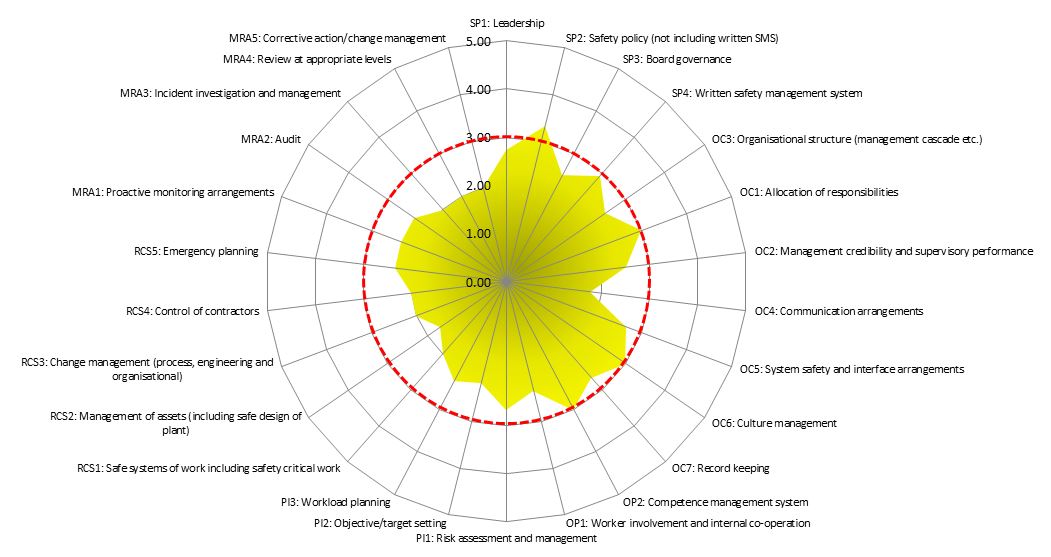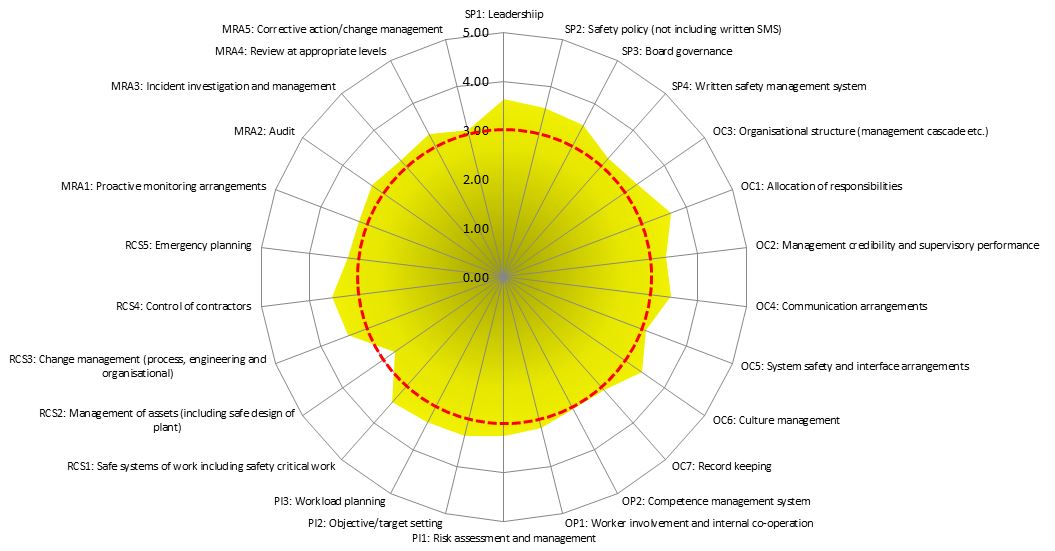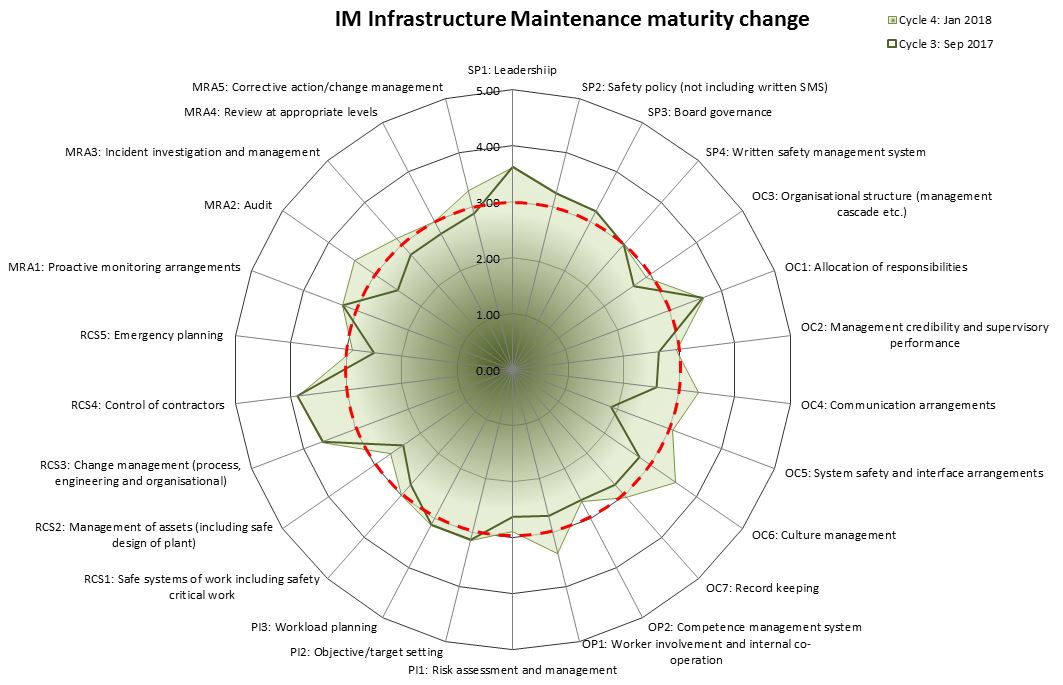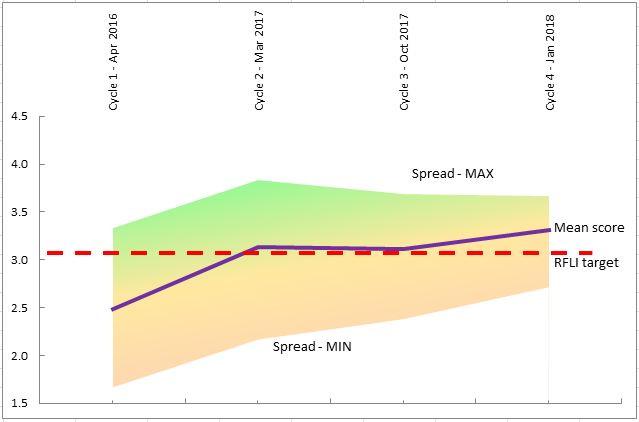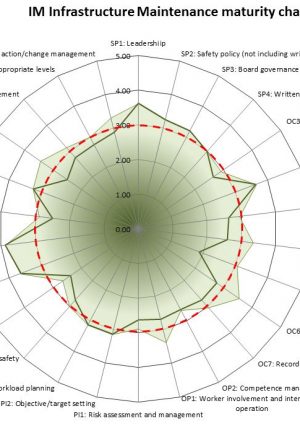
Using the RM3 process at Crossrail to develop maturity and safety in a new organisation
Document
type: Micro-report
Author:
Tim Lyons MA FAPM
Publication
Date: 14/08/2018
-
Abstract
The Office of Rail and Road has adapted its Risk Management Maturity Model (RM3) from the HSG65 HSE guideline and made it relevant to rail organisations. The model defines excellence on a 5-point scale, across a number of different disciplines.
This micro-report describes how Crossrail applied this approach in an innovative way, combining it with thinking from the Common Safety Method (CSM) to examine and score the hazards resulting from NOT increasing in maturity and to assess new and novel mitigations used.
-
Read the full document
Introduction and Industry Context
In order to satisfy the ORR that RFLI had an adequate Safety Management System in place, there had to be a Hazard Record that identified hazards and then showed how each is being controlled. For RFLI, a three-tier Hazard Record was developed: At the top – the creation from scratch of a new organisation to manage the Elizabeth line; the second level comprised ‘conventional’ (RSSB) railway hazards; the third level was Workplace Risk Assessments associated with Crossrail’s unique topology, systems and working methods.
Accordingly, the ORR’s Risk Management Maturity Model (RM3) was selected in 2015 to assess RFLI’s maturity as a new organisation.
RM3 uses a model that divides the measurement of management excellence into five elements, each broken down into a number of sub-elements.
Figure 1 – The Wheel of RM3 (© ORR)
Each sub-element is assessed according to a pre-set maturity scale with five levels:
Maturity Described as Meaning 5 Goal (excellence) Consistently and systematically done; done by all; policies exist 4 Predictable Managed proactively; need understood by all; not at policy level 3 Standardised Managed the same way but not at policy level 2 Managed Managed at local level, little overall coordination, not systematic 1 Ad Hoc Managed reactively, different each time, not systematic Using this scale, the method used by a team to ensure, say ‘Proactive Monitoring’ can be judged to meet one of the maturity levels. This was done using an audit approach with multiple assessors; systems and methods proposed by a team as their means of doing Proactive Monitoring were examined and observed and then scored by consensus of the HSE team and the representative of the team being assessed.
Innovation introduced in the Crossrail implementation of RM3
One weakness of the native application of RM3 stems from its reliance on the judgement of those involved in the scoring process. In order to provide more objectivity, our team reversed the sense of maturity measurement, instead considering the hazards to the organisation if maturity was poor or not achieved. This allowed us to apply another standard guideline – the Common Safety Method for Risk Assessment (CSM) – to properly assess the strength of proposed mitigation of each hazard.
CSM requires that a risk is assessed as to whether it is Broadly Acceptable, in which case no further assessment is needed. If it is not Broadly Acceptable, a Risk Acceptance Principle (RAP) must be deployed which points to an accepted Standard or Code of Practice, an Equivalent Reference system already proven in use, or if none of these apply, an Explicit Risk Evaluation must be carried out.
A cyclical programme of 6-monthly audits was put in place to assess how selected teams were reducing the risks of immature management by putting mitigation in place to deal with each measured element. Teams initially selected were Engineering, Maintenance and Operations (these being the key ‘production’ departments) and later, the senior management team was added. A procedure for carrying out audits and subsequent scoring was written and followed. In broad terms this followed the sequence in Figure 2.
Figure 2 – Sequence followed during RM3 process
Initial results were expectedly low in maturity; however one finding was that teams were deploying systems and methods used on previous projects, as these were trusted. After assessment and scoring, initial results showed where maturity was weakest and needed improvement:
Figure 3 – Results across all teams after Cycle 1
This was used to analyse and prioritise corrective actions for each team to increase its maturity levels. These were followed up as part of the next cycle and gradually, as systems and techniques improved, so did the measured maturity levels:
Figure 4 – Results showing improvements across all teams after Cycle 4
Visualisation of maturity through comparative charts allowed an individual team to see where its score had most improved, or still needed work:
Figure 5 – Chart showing incremental improvements in scores (Cycle 3 – Cycle 4)
Another welcome result was that as RM3 became more embedded and teams engaged with it, the spread between the most and least immature results narrowed:
Figure 6 – Spread of maturity narrowed as teams became more mature
Lessons learned
- The use of RM3 as an industry standard tool for measuring and improving maturity in an emerging railway organisation has proven extremely valuable.
- Enhancing objectivity by linking assessment methods to the Common Safety Method was a worthwhile innovation.
- Using graphical methods of display (as shown here) helped to bring about better engagement within teams.
- RM3 was used as the highest level of the RFLI’s Hazard Record and showed how its management methods were managing risk at an organisational level.
- RFLI actively subjected its RM3 process to 3rd party scrutiny from its Assessment Body (AsBo) and also TfL’s Internal Audit (both agreed the process was adequately controlled).
- The RM3 process has to be embedded culturally and needs an active team or initiative to drive it through and keep it going. Not to do so could risk organisational complacency with attendant hazard creep.
Recommendations for Future Projects
Use of an organisational maturity measurement tool is strongly recommended. RM3 is aimed at the railway industry; however it can be adapted and scaled for many sectors, being built on the more general HSG65 guideline. Introducing such a method into management structures at an early stage will yield a strong, self-reflective scrutiny that will support many other initiatives such as the ISO9001 Quality initiative.
-
Authors
Tim Lyons MA FAPM - Crossrail Ltd
Tim Lyons is a Programme Manager in the Crossrail Operations Directorate. During an early career as a broadcast engineer and then Chief Engineer, he built, commissioned and operated a number of commercial radio and recording studios. Managing deadlines led to an interest in project management and a second career in development and sales of PC-based critical path tools. Also trained as a business coach, Tim coaches individuals and teams in the pursuit of business excellence. A current Crossrail initiative combines the ORR’s Risk Management Maturity Model with the Common Safety Method to build a safe, mature Infrastructure Manager organisation.


